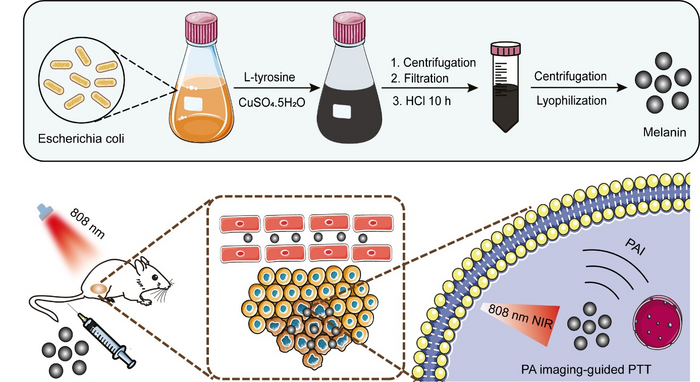
Courtesy of ACS Omega and the researchers
Nice illustration! I wish I could credit the artist. For anyone who needs a little text to make sense of it, there’s a Sept. 27, 2017 news item on Nanowerk (Note: A link has been removed),
For hundreds of years, Chinese calligraphers have used a plant-based ink to create beautiful messages and art. Now, one group reports in ACS Omega (“New Application of Old Material: Chinese Traditional Ink for Photothermal Therapy of Metastatic Lymph Nodes”) that this ink could noninvasively and effectively treat cancer cells that spread, or metastasize, to lymph nodes.
A Sept. 27, 2017 American Chemical Society (ACS) news release, which originated the news item, reveals more about the research,
As cancer cells leave a tumor, they frequently make their way to lymph nodes, which are part of the immune system. In this case, the main treatment option is surgery, but this can result in complications. Photothermal therapy (PTT) is an emerging noninvasive treatment option in which nanomaterials are injected and accumulate in cancer cells. A laser heats up the nanomaterials, and this heat kills the cells. Many of these nanomaterials are expensive, difficult-to-make and toxic. However, a traditional Chinese ink called Hu-Kaiwen ink (Hu-ink) has similar properties to the nanomaterials used in PTT. For example, they are the same color, and are both carbon-based and stable in water. So Wuli Yang and colleagues wanted to see if Hu-ink could be a good alternative material for PTT.
The researchers analyzed Hu-ink and found that it consists of nanoparticles and thin layers of carbon. When Hu-ink was heated with a laser, its temperature rose by 131 degrees Fahrenheit, much higher than current nanomaterials. Under PPT conditions, the Hu-ink killed cancer cells in a laboratory dish, but under normal conditions, the ink was non-toxic. This was also the scenario observed in mice with tumors. The researchers also noted that Hu-ink could act as a probe to locate tumors and metastases because it absorbs near-infrared light, which goes through skin.
Being a little curious about Hu-ink’s similarity to nanomaterial, I looked for more detail in the the paper (Note: Links have been removed), From the: Introduction,
Photothermal therapy (PTT) is an emerging tumor treatment strategy, which utilizes hyperthermia generated from absorbed near-infrared (NIR) light energy by photoabsorbing agents to kill tumor cells.(7-13) Different from chemotherapy, surgical treatment, and radiotherapy, PTT is noninvasive and more efficient.(7, 14, 15) In the past decade, PTT with diverse nanomaterials to eliminate cancer metastases lymph nodes has attracted extensive attention by several groups, including our group.(3, 16-20) For instance, Liu and his co-workers developed a treatment method based on PEGylated single-walled carbon nanotubes for PTT of tumor sentinel lymph nodes and achieved remarkably improved treatment effect in an animal tumor model.(21) To meet the clinical practice, the potential metastasis of deeper lymph nodes was further ablated in our previous work, using magnetic graphene oxide as a theranostic agent.(22) However, preparation of these artificial nanomaterials usually requires high cost, complicated synthetic process, and unavoidably toxic catalyst or chemicals,(23, 24) which impede their future clinical application. For the clinical application, exploring an environment-friendly material with simple preparation procedure, good biocompatibility, and excellent therapeutic efficiency is still highly desired. [emphases mine]
From the: Preparation and Characterization of Hu-Ink
To obtain an applicable sample, the condensed Hu-ink was first diluted into aqueous dispersion with a lower concentration. The obtained Hu-ink dispersion without any further treatment was black in color and stable in physiological environment, including water, phosphate-buffered saline (PBS), and Roswell Park Memorial Institute (RPMI) 1640; furthermore, no aggregation was observed even after keeping undisturbed for 3 days (Figure 2a). The nanoscaled morphology of Hu-ink was examined by transmission electron microscopy (TEM) (Figure 2b), which demonstrates that Hu-ink mainly exist in the form of small aggregates. These small aggregates consist of a few nanoparticles with diameter of about 20–50 nm. Dynamic light scattering (DLS) measurement (Figure 2c) further shows that Hu-ink aqueous dispersion possesses a hydrodynamic diameter of about 186 nm (polydispersity index: 0.18), which was a crucial prerequisite for biomedical applications.(29) In the X-ray diffraction (XRD) pattern, no other characteristic peaks are found except carbon peak (Figure S1, Supporting Information), which confirms that the main component of Hu-ink is carbon.(25) Raman spectroscopy was a common tool to characterize graphene-related materials.(30) D band (∼1300 cm–1, corresponding to the defects) and G band (∼1600 cm–1, related to the sp2 carbon sites) peaks could be observed in Figure 2d with the ratio ID/IG = 0.96, which confirms the existence of graphene sheetlike structure in Hu-ink.(31) The UV–vis–NIR spectra (Figure 2e) also revealed that Hu-ink has high absorption in the NIR region around 650–900 nm, in which hemoglobin and water, the major absorbers of biological tissue, have their lowest absorption coefficient.(32) The high NIR absorption capability of Hu-ink encouraged us to investigate its photothermal properties.(33-35) Hu-ink dispersions with different concentrations were irradiated under an 808 nm laser (the commercial and widely used wavelength in photothermal therapy).(8-13) [emphases mine]
…
Curiosity satisfied! For those who’d like to investigate even further, here’s a link to and a citation for the paper,
New Application of Old Material: Chinese Traditional Ink for Photothermal Therapy of Metastatic Lymph Nodes by Sheng Wang, Yongbin Cao, Qin Zhang, Haibao Peng, Lei Liang, Qingguo Li, Shun Shen, Aimaier Tuerdi, Ye Xu, Sanjun Cai, and Wuli Yang. ACS Omega, 2017, 2 (8), pp 5170–5178 DOI: 10.1021/acsomega.7b00993 Publication Date (Web): August 30, 2017
Copyright © 2017 American Chemical Society
This paper appears to be open access.

